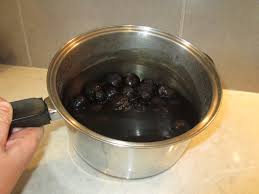 Soak the browned husks of walnuts in water. Or cook them for an hour, until you find it dark enough. Let stand for 1 day. Filter. More layers is also darker. Keep it cool, it's perishable.
Soak the browned husks of walnuts in water. Or cook them for an hour, until you find it dark enough. Let stand for 1 day. Filter. More layers is also darker. Keep it cool, it's perishable.
Turpentine (oil) with tar can also be used as wood stain.
Varnish is a chemical reduction to protect from light, moisture or mold.
Formerly varnish was made of, inter alia, resin or shellac dissolved in alcohol or oil.
Sustainable: burned wood
Harding wood and making it more sustainable was applied by charring it partly to harden spearheads and arrowheads (see <spear>) and treat pasture poles (see <fence).
In the Japanese shou sugi ban (black wood) technique for preserving wood cedar or cypress is "burned" on the surface by creating a chimney with 3 or 4 planks and burn a short fire through it. The charred layer provides resistance to weather, spread of fire, insects and fungi. The excess carbon is brushed with water and after drying it can be treated with a natural oil.
It seems not (yet) proved that "Charred Wood 'is an effective treatment.
The impregnated green wood is on the surface preserved with creosote salts, a cocktail of copper, chromium and arsenic. They protect the so-called CCA wood against fungi and bacteria, but on the long run the heavy metals are released into the environment: soil, groundwater or exhaust air from the waste treatment plant. After use, the timber should be treated as hazardous waste! Shredding or burning is not allowed.
StellacWood, from the Finnish company Stellac preserves wood by cooking and baking it without oxygen at more than 200 degrees Celsius.
The wood is usable even for bridges and harsh outdoor applications in permanently wet conditions. It is as durable as high-quality hardwoods and gets a lifetime of at least 25 years. Pine and birch woods lend themselves best to this. The treatment gives the wood a darker shade: pine is chocolate brown, birch wood colors like ebony.
